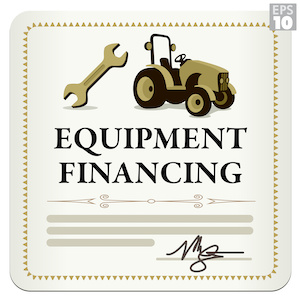Fair Market Value (FMV) lease vs. $1 Dollar
Buyout Lease (Equipment Financing Agreement, EFA)
Are you considering adding equipment to improve operations and boost productivity in your business? Instead of buying expensive equipment outright you could consider leasing new equipment. Leasing offers an affordable way to acquire, upgrade, or update business equipment while preserving working capital, cash used to run your daily operations.
Two kinds of equipment leases are available:
- Fair Market Value (FMV) lease
- Dollar ($1) Buyout Lease (also called Equipment Financing Agreement, EFA)

Here are what you need to know to make the best decision for your company:
Fair Market Value Lease
A Fair Market Value lease, also known as an operating lease, functions like a rental agreement. You don’t own the equipment you’re leasing. A good example is car leasing, where an FMV lease allows the lessee to use the equipment (car) for a pre-arranged time period for a fixed monthly payment. At the end of the lease term, the lessee has the option to purchase the equipment at its then-determined Fair Market Value, continue making your lease payments and using the equipment, return the equipment, or upgrade to new equipment.
- FMVs are often the most affordable leases.
- FMV leases are commonly used to acquire the types of new equipment that go out of date quickly and lose most of their value, ownership doesn’t have many benefits. Examples are: IT equipment, including computers and tablets, servers, software, security systems, GPS, phone system, or other technology-based equipment. Other examples include: fork trucks, HVAC systems, solar panels, LED lighting, and other energy needs for buildings.
- FMV leases are often used when the company does not want to retain the equipment at the end of the lease term.
- FMV leases help manage the cost of continuous upgrades, and can prevent the inefficiencies and maintenance issues related to aging and outdated technology equipment.
- FMV lease terms usually range from 12 to 60 months.
- FMV leases feature a fixed monthly payment.
- Since the lessee does not own the equipment it does not appear on the company’s balance sheet, allowing the lessee to deduct the monthly lease payments as an operating expense.
- To qualify for an FMV lease, the applicant must have a good credit score.
Dollar ($1) Buyout Lease (Equipment Financing Agreement)

- Higher monthly payment compared with an FMV lease.
- $1 Buyout Leases are often used for equipment that retains its value over time, such as construction equipment, automotive repair, material handling, tooling, cleaning equipment and pressure washers.
- $1 Buyout Leases have a set lease term
- Fixed monthly payments
- Equipment ownership is often transferred to the lessee, and the equipment appears on the balance sheet as company assets.
- For tax purposes, there are benefits to leasing the equipment with a $1 Buyout, rather than purchasing it. The purchased equipment will appear as an asset on your business’ balance sheet, and the lease will appear as a corresponding liability. For tax purposes, using Section 179, it is possible to deduct the entire equipment purchase (some restrictions may apply) as a business expense in the first year of purchase. you may be able to write off the entire cost of the equipment in the first year as “bonus” depreciation under the Tax Cuts and Jobs Act. This bonus depreciation is available for any qualified asset that you purchase and put into use before 2023.
- At the end of the lease term, the lessee purchases the equipment for $1.
Comparing FMV and $1 Buyout Leases
Which type of equipment financing is right for your business? Both FMV leases and $1 buyout leases have pros and cons:
FMV lease:
- Pros:
- Tend to be relatively affordable
- Easy to keep equipment up to date; you can return old equipment and lease newer equipment when the lease term ends
- Scales well; you can get the right amount and type of equipment you need now, and then adjust as needed. You don’t have to make newer assets work alongside older ones, which is especially useful in fields like IT, where compatibility can be an issue.
- Your financing partner deals with equipment management and disposal
- Reduced cost for use of the equipment
- Option to walk away from the equipment when the lease ends
- Lease is usually shorter in term
- Some tax benefits (can deduct monthly lease payments as an operating expense)
- Many business owners can get 100 percent financing with no down payment
- Cons:
- May be more difficult to finance used equipment or highly specialized items
- May involve stricter requirements to qualify
- Doesn’t give ownership of the equipment (can also be a “pro”)
$1 buyout lease/equipment finance agreement
- Pros:
- You own the equipment
- Excellent tax benefits; you may be able to take 100 percent bonus depreciation (Section 179) in the first year
- Many business owners can get 100 percent financing with no down payment
- Cons:
- May cost more, since you purchase the equipment and receive ownership
- You’re responsible for equipment management and maintenance
- Typically not available for startup companies (less than two year in existence.)
There are some variation to the above two major equipment financing options. One example is the Term Residual Lease acts as a standard option to either purchase or return the equipment at the completion of the original term. The difference under the Term Residual Lease compared to a regular FMV lease is that the standard lease term of 24, 36, or 48 months has been shortened to 22, 33, or 44 monthly payments. If the customer desires to purchase the equipment at the end of the shortened term they may do so by making 2 additional payments on a 22-month lease term (24 payments to own), 3 additional on a 33-month lease term (36 payments to own) and 4 on a 44-month term (48 payments to own). Under the Term Residual Lease the purchase option is spread out over a number of payments.
Which solution works best often comes down to the type of equipment you want to finance, as well as your business cash flow and tax situation. An FMV equipment lease usually makes sense if your business needs to stay current, and you update equipment frequently. If you plan to use the asset for a long time or think you can sell it for a good value when you’re finished using it, then a $1 buyout lease may be the best solution.
Bibliographies:
- https://teamfinancialgroup.com/blog/1-buyout-lease-vs-fmv-lease-whats-the-difference/ accessed on 04/20/2021.
- https://www.crestmark.com/fair-market-value-lease-vs-1-buyout-lease-need-know/ accessed on 04/20/2021.
- Pawnee Leasing Corporation JANUARY 2021 BROKER RATE SCHEDULES & GUIDELINES
American Credit®, Inc website: amcredit.com
